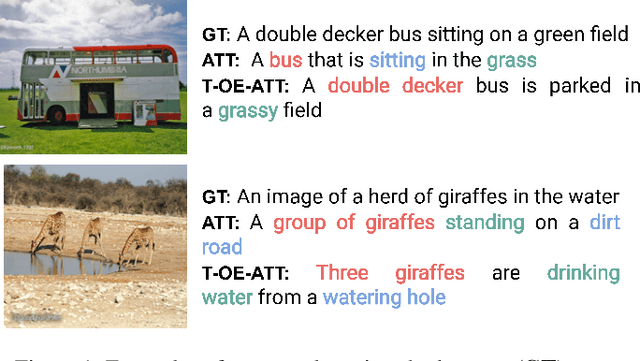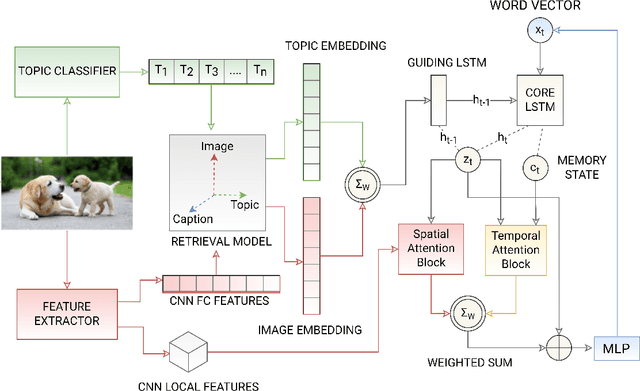Shah Nawaz
A Multimodal Single-Branch Embedding Network for Recommendation in Cold-Start and Missing Modality Scenarios
Sep 26, 2024Abstract:Most recommender systems adopt collaborative filtering (CF) and provide recommendations based on past collective interactions. Therefore, the performance of CF algorithms degrades when few or no interactions are available, a scenario referred to as cold-start. To address this issue, previous work relies on models leveraging both collaborative data and side information on the users or items. Similar to multimodal learning, these models aim at combining collaborative and content representations in a shared embedding space. In this work we propose a novel technique for multimodal recommendation, relying on a multimodal Single-Branch embedding network for Recommendation (SiBraR). Leveraging weight-sharing, SiBraR encodes interaction data as well as multimodal side information using the same single-branch embedding network on different modalities. This makes SiBraR effective in scenarios of missing modality, including cold start. Our extensive experiments on large-scale recommendation datasets from three different recommendation domains (music, movie, and e-commerce) and providing multimodal content information (audio, text, image, labels, and interactions) show that SiBraR significantly outperforms CF as well as state-of-the-art content-based RSs in cold-start scenarios, and is competitive in warm scenarios. We show that SiBraR's recommendations are accurate in missing modality scenarios, and that the model is able to map different modalities to the same region of the shared embedding space, hence reducing the modality gap.
Modality Invariant Multimodal Learning to Handle Missing Modalities: A Single-Branch Approach
Aug 14, 2024



Abstract:Multimodal networks have demonstrated remarkable performance improvements over their unimodal counterparts. Existing multimodal networks are designed in a multi-branch fashion that, due to the reliance on fusion strategies, exhibit deteriorated performance if one or more modalities are missing. In this work, we propose a modality invariant multimodal learning method, which is less susceptible to the impact of missing modalities. It consists of a single-branch network sharing weights across multiple modalities to learn inter-modality representations to maximize performance as well as robustness to missing modalities. Extensive experiments are performed on four challenging datasets including textual-visual (UPMC Food-101, Hateful Memes, Ferramenta) and audio-visual modalities (VoxCeleb1). Our proposed method achieves superior performance when all modalities are present as well as in the case of missing modalities during training or testing compared to the existing state-of-the-art methods.
Chameleon: Images Are What You Need For Multimodal Learning Robust To Missing Modalities
Jul 23, 2024Abstract:Multimodal learning has demonstrated remarkable performance improvements over unimodal architectures. However, multimodal learning methods often exhibit deteriorated performances if one or more modalities are missing. This may be attributed to the commonly used multi-branch design containing modality-specific streams making the models reliant on the availability of a complete set of modalities. In this work, we propose a robust textual-visual multimodal learning method, Chameleon, that completely deviates from the conventional multi-branch design. To enable this, we present the unification of input modalities into one format by encoding textual modality into visual representations. As a result, our approach does not require modality-specific branches to learn modality-independent multimodal representations making it robust to missing modalities. Extensive experiments are performed on four popular challenging datasets including Hateful Memes, UPMC Food-101, MM-IMDb, and Ferramenta. Chameleon not only achieves superior performance when all modalities are present at train/test time but also demonstrates notable resilience in the case of missing modalities.
Face-voice Association in Multilingual Environments (FAME) Challenge 2024 Evaluation Plan
Apr 16, 2024Abstract:The advancements of technology have led to the use of multimodal systems in various real-world applications. Among them, the audio-visual systems are one of the widely used multimodal systems. In the recent years, associating face and voice of a person has gained attention due to presence of unique correlation between them. The Face-voice Association in Multilingual Environments (FAME) Challenge 2024 focuses on exploring face-voice association under a unique condition of multilingual scenario. This condition is inspired from the fact that half of the world's population is bilingual and most often people communicate under multilingual scenario. The challenge uses a dataset namely, Multilingual Audio-Visual (MAV-Celeb) for exploring face-voice association in multilingual environments. This report provides the details of the challenge, dataset, baselines and task details for the FAME Challenge.
Frame-to-Utterance Convergence: A Spectra-Temporal Approach for Unified Spoofing Detection
Sep 18, 2023Abstract:Voice spoofing attacks pose a significant threat to automated speaker verification systems. Existing anti-spoofing methods often simulate specific attack types, such as synthetic or replay attacks. However, in real-world scenarios, the countermeasures are unaware of the generation schema of the attack, necessitating a unified solution. Current unified solutions struggle to detect spoofing artifacts, especially with recent spoofing mechanisms. For instance, the spoofing algorithms inject spectral or temporal anomalies, which are challenging to identify. To this end, we present a spectra-temporal fusion leveraging frame-level and utterance-level coefficients. We introduce a novel local spectral deviation coefficient (SDC) for frame-level inconsistencies and employ a bi-LSTM-based network for sequential temporal coefficients (STC), which capture utterance-level artifacts. Our spectra-temporal fusion strategy combines these coefficients, and an auto-encoder generates spectra-temporal deviated coefficients (STDC) to enhance robustness. Our proposed approach addresses multiple spoofing categories, including synthetic, replay, and partial deepfake attacks. Extensive evaluation on diverse datasets (ASVspoof2019, ASVspoof2021, VSDC, partial spoofs, and in-the-wild deepfakes) demonstrated its robustness for a wide range of voice applications.
DCTM: Dilated Convolutional Transformer Model for Multimodal Engagement Estimation in Conversation
Jul 31, 2023Abstract:Conversational engagement estimation is posed as a regression problem, entailing the identification of the favorable attention and involvement of the participants in the conversation. This task arises as a crucial pursuit to gain insights into human's interaction dynamics and behavior patterns within a conversation. In this research, we introduce a dilated convolutional Transformer for modeling and estimating human engagement in the MULTIMEDIATE 2023 competition. Our proposed system surpasses the baseline models, exhibiting a noteworthy $7$\% improvement on test set and $4$\% on validation set. Moreover, we employ different modality fusion mechanism and show that for this type of data, a simple concatenated method with self-attention fusion gains the best performance.
Single-branch Network for Multimodal Training
Mar 10, 2023Abstract:With the rapid growth of social media platforms, users are sharing billions of multimedia posts containing audio, images, and text. Researchers have focused on building autonomous systems capable of processing such multimedia data to solve challenging multimodal tasks including cross-modal retrieval, matching, and verification. Existing works use separate networks to extract embeddings of each modality to bridge the gap between them. The modular structure of their branched networks is fundamental in creating numerous multimodal applications and has become a defacto standard to handle multiple modalities. In contrast, we propose a novel single-branch network capable of learning discriminative representation of unimodal as well as multimodal tasks without changing the network. An important feature of our single-branch network is that it can be trained either using single or multiple modalities without sacrificing performance. We evaluated our proposed single-branch network on the challenging multimodal problem (face-voice association) for cross-modal verification and matching tasks with various loss formulations. Experimental results demonstrate the superiority of our proposed single-branch network over the existing methods in a wide range of experiments. Code: https://github.com/msaadsaeed/SBNet
Speaker Recognition in Realistic Scenario Using Multimodal Data
Feb 25, 2023Abstract:In recent years, an association is established between faces and voices of celebrities leveraging large scale audio-visual information from YouTube. The availability of large scale audio-visual datasets is instrumental in developing speaker recognition methods based on standard Convolutional Neural Networks. Thus, the aim of this paper is to leverage large scale audio-visual information to improve speaker recognition task. To achieve this task, we proposed a two-branch network to learn joint representations of faces and voices in a multimodal system. Afterwards, features are extracted from the two-branch network to train a classifier for speaker recognition. We evaluated our proposed framework on a large scale audio-visual dataset named VoxCeleb$1$. Our results show that addition of facial information improved the performance of speaker recognition. Moreover, our results indicate that there is an overlap between face and voice.
Learning Branched Fusion and Orthogonal Projection for Face-Voice Association
Aug 22, 2022



Abstract:Recent years have seen an increased interest in establishing association between faces and voices of celebrities leveraging audio-visual information from YouTube. Prior works adopt metric learning methods to learn an embedding space that is amenable for associated matching and verification tasks. Albeit showing some progress, such formulations are, however, restrictive due to dependency on distance-dependent margin parameter, poor run-time training complexity, and reliance on carefully crafted negative mining procedures. In this work, we hypothesize that an enriched representation coupled with an effective yet efficient supervision is important towards realizing a discriminative joint embedding space for face-voice association tasks. To this end, we propose a light-weight, plug-and-play mechanism that exploits the complementary cues in both modalities to form enriched fused embeddings and clusters them based on their identity labels via orthogonality constraints. We coin our proposed mechanism as fusion and orthogonal projection (FOP) and instantiate in a two-stream network. The overall resulting framework is evaluated on VoxCeleb1 and MAV-Celeb datasets with a multitude of tasks, including cross-modal verification and matching. Results reveal that our method performs favourably against the current state-of-the-art methods and our proposed formulation of supervision is more effective and efficient than the ones employed by the contemporary methods. In addition, we leverage cross-modal verification and matching tasks to analyze the impact of multiple languages on face-voice association. Code is available: \url{https://github.com/msaadsaeed/FOP}
Guiding Attention using Partial-Order Relationships for Image Captioning
Apr 15, 2022



Abstract:The use of attention models for automated image captioning has enabled many systems to produce accurate and meaningful descriptions for images. Over the years, many novel approaches have been proposed to enhance the attention process using different feature representations. In this paper, we extend this approach by creating a guided attention network mechanism, that exploits the relationship between the visual scene and text-descriptions using spatial features from the image, high-level information from the topics, and temporal context from caption generation, which are embedded together in an ordered embedding space. A pairwise ranking objective is used for training this embedding space which allows similar images, topics and captions in the shared semantic space to maintain a partial order in the visual-semantic hierarchy and hence, helps the model to produce more visually accurate captions. The experimental results based on MSCOCO dataset shows the competitiveness of our approach, with many state-of-the-art models on various evaluation metrics.
 Add to Chrome
Add to Chrome Add to Firefox
Add to Firefox Add to Edge
Add to Edge